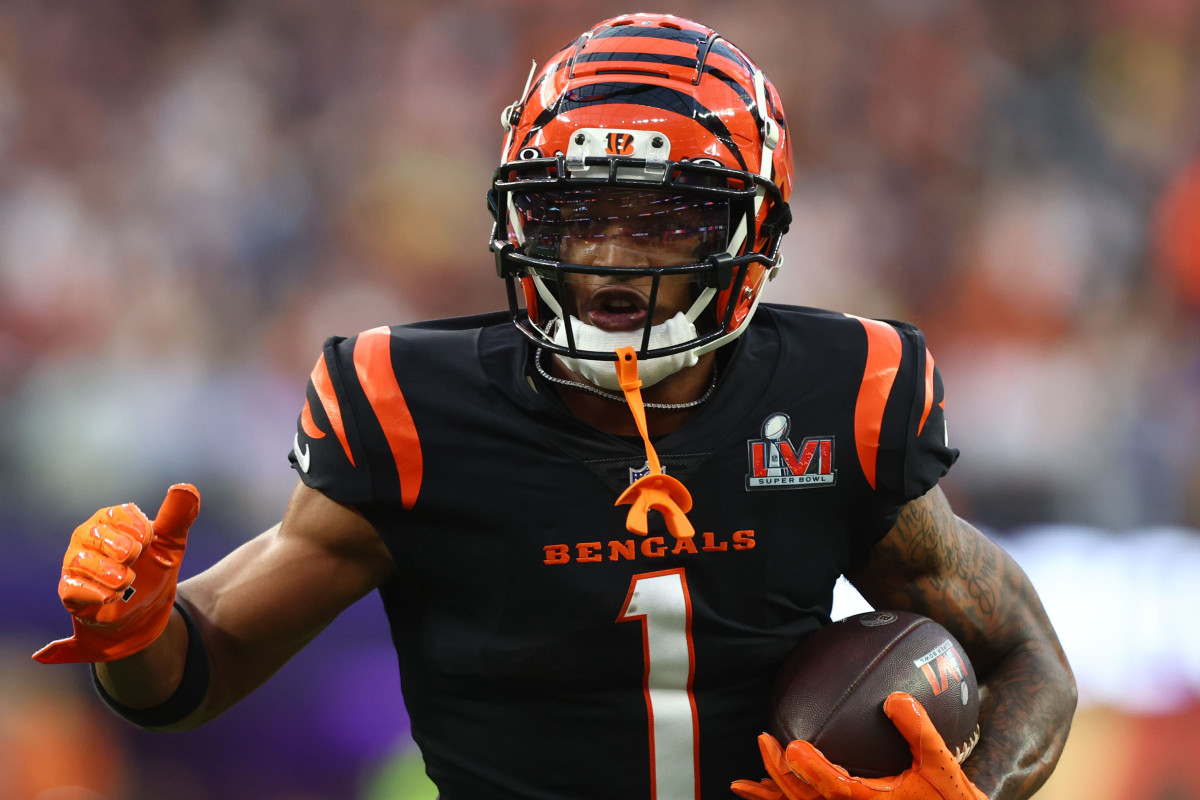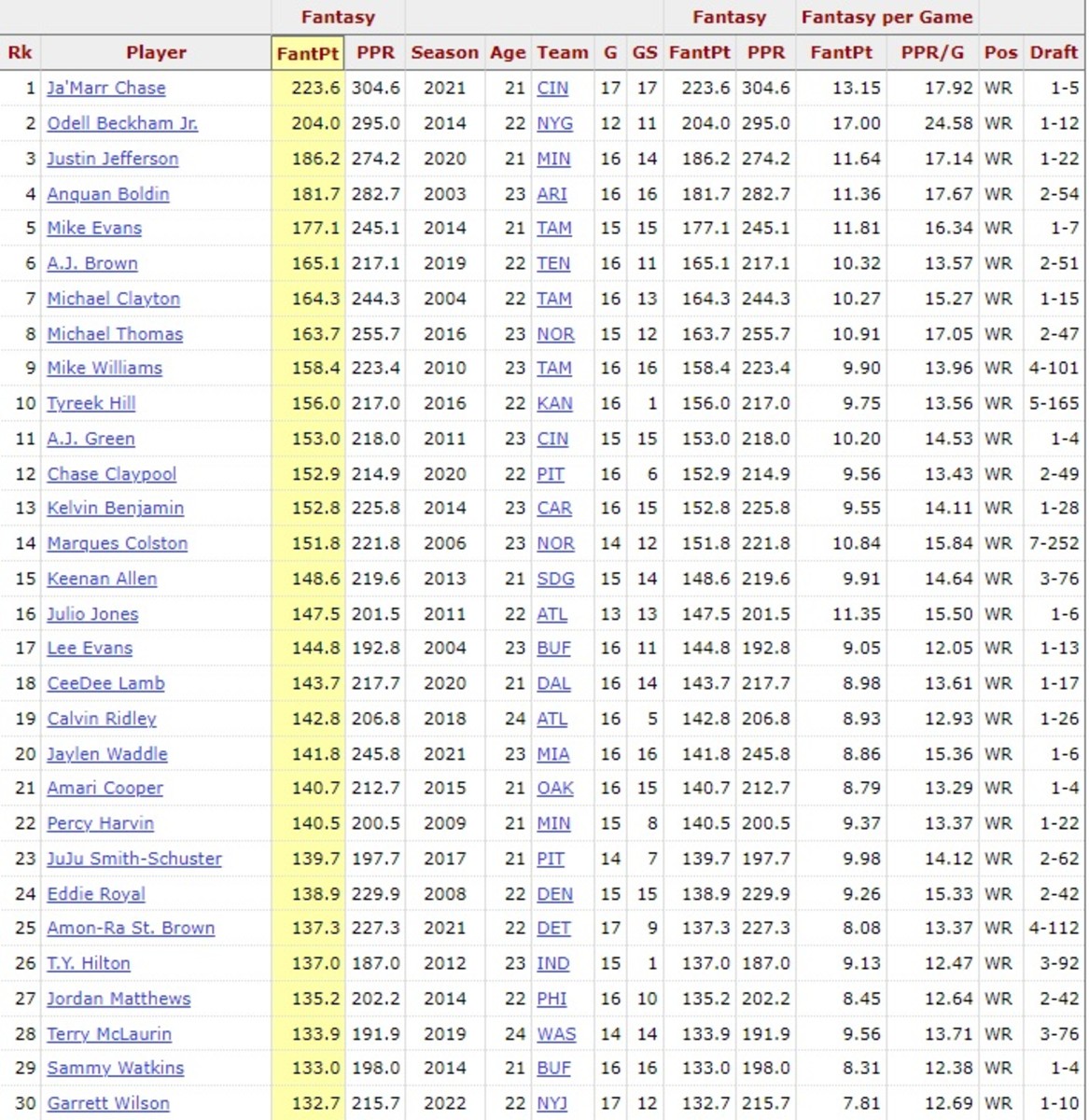NFL Draft: Best Fantasy Rookie Wide Receivers Since 2000
Rookies have become a much bigger part of the fantasy landscape in recent seasons. In years past, it was the first-year running backs who typically made the most significant statistical impacts among rookies. But nowadays, we’re seeing an increased number of wide receivers come right in and finish with solid totals.
Don’t believe me?
Well, look at what we’ve seen in just the last few years from the likes of Ja’Marr Chase, Justin Jefferson, CeeDee Lamb, Jaylen Waddle and Amon-Ra St. Brown (to name a few). We’re no longer in an era where we have to wait a year or two for a wideout to shine. More often, it’s now happening almost instantaneously.
Does that mean we’ll see similar outcomes from the 2023 class of wideouts? Well, let’s go down memory lane and examine first-year players at the position since 2000 to see what trends we can unearth that can help us be better drafters.
After all, several of the projected first-round selections in recent NFL mock drafts are wide receivers, including the likes of Ohio State’s Jaxon Smith-Njigba, USC’s Jordan Addison, TCU’s Quentin Johnston and Zay Flowers from Boston College. In what is a passing league, wideouts have become even more valuable in the NFL.
Alright, let’s get into it.
Since 2000, we have seen a combined 38 rookie wide receivers score at least 185 fantasy points. By comparison, that total was good enough to finish in the top 30 in 2022. Of those 38 rookies, 25 scored more than 200 points, including five who had over 250. One receiver, Chase, scored over 300 points in his rookie season.
The overall top 10 fantasy rookies since 2000:

Ja’Marr Chase (2021)
Odell Beckham Jr. (2014)
Anquan Boldin (2003)
Justin Jefferson (2020)
Michael Thomas (2016)
Jaylen Waddle (2021)
Mike Evans (2014)
Michael Clayton (2004)
Eddie Royal (2008)
Amon-Ra St. Brown (2021)
If we look at the overall top 10 fantasy wideouts, we find that four of them are from the last three years. That quartet is Chase, Jefferson, Waddle and St. Brown. If we extend out to the top 20, we find four others that made their NFL debuts in the last five years. In all, eight of the top 20 have happened in the last five years.
That’s not a surprise, though, as more NFL offenses have taken advantage of the rules that favor more of an aerial attack. From a fantasy perspective, this also makes it more feasible to take chances on rookie wide receivers than in years past, when a first-year breakout was a less likely occurrence.
That brings me to the next trend I’ve seen among our top 20 fantasy wideouts since 2000, and it’s an interesting one. While we’re seeing more receivers make an impact quicker, just five of the 20 players finished better than WR13 in their rookie season. What’s more, 12 of them finished between WR15 and WR23 (mid-No. 2).
So, getting a rookie like Chase, OBJ, Boldin or Jefferson to pop isn’t a norm at the position. Furthermore, it’s more likely you’ll get a WR2 based on this data.
Of course, targets and catches are also vital to statistical success. Among our top 20 rookies, two (A.J. Brown, Tyreek Hill) had fewer than 104 targets. Opportunities are huge regardless of position, so looking for a rookie receiver (in this case) who ends up with a team that has a need for playmakers in the passing game is obvious.
Another trend we should notice is that the majority of the top rookie fantasy wideouts have been selected in the first three rounds of the NFL draft. In fact, nine of the top 10 in our research have been first- or second-rounders. The lone exception has been St. Brown, who was a fourth-round pick of the Detroit Lions.
Even if I dive in a little bit deeper, just three other wide receivers in the overall top 30 were picked outside of the top three rounds in their respective drafts. That trio is Mike Williams (2010), Marques Colston (2006) and Tyreek Hill (2016). If I extend to those who finished No. 21 to No. 50, we find just two other examples. One is Willie Snead (undrafted in 2015), and the other is Darius Slayton (Round 5, 2019).

What it means for 2023
Now let’s look at the incoming class of wideouts and see who might fit the bill for our historical trends. As I mentioned earlier in the column, Smith-Njigba, Addison, Johnston and Flowers all project as first rounders. Other wideouts like Jalin Hyatt from Tennessee and North Carolina’s Josh Downs (among others) will be on the first-round radar and will certainly be in the Day 2 mix for many NFL franchises.
Historically, that’s what we want.
Smith-Njigba was hurt for most of last season, but he hauled in 95 catches in 2021 in a formidable Big Ten Conference. Addison had a combined 219 catches in 35 games between Pittsburgh and USC, and Flowers went for 78 catches in his final season at BC. Johnston, who didn’t post big catch totals, might end up being the least likely to shine as a rookie despite being projected as the top wideout by some NFL scouts. Downs, a possible sleeper, had 195 catches over the last two years.
This position doesn’t have a Bijan Robinson-level talent (someone who is head and shoulders above the rest of the players at his position), as you’ll see in looking at different mocks. However, the aforementioned wideouts are likely the ones who will be most prominently selected in real NFL draft and in fantasy land.
Remember, just six of the top 50 fantasy wideouts in the last 23 years were picked outside of the top three rounds. That is just 8.3%, so finding a rookie wide receiver outside of the top three rounds who makes a huge fantasy impact is difficult.
Michael Fabiano is an award-winning fantasy football analyst on Sports Illustrated and a member of the Fantasy Sports Writers Association (FSWA) Hall of Fame. Click here to read all his articles here on SI Fantasy. You can follow Michael on Twitter, Facebook, YouTube, and Instagram for your late-breaking fantasy news and the best analysis in the business to help you win a fantasy championship!
